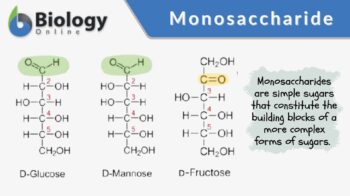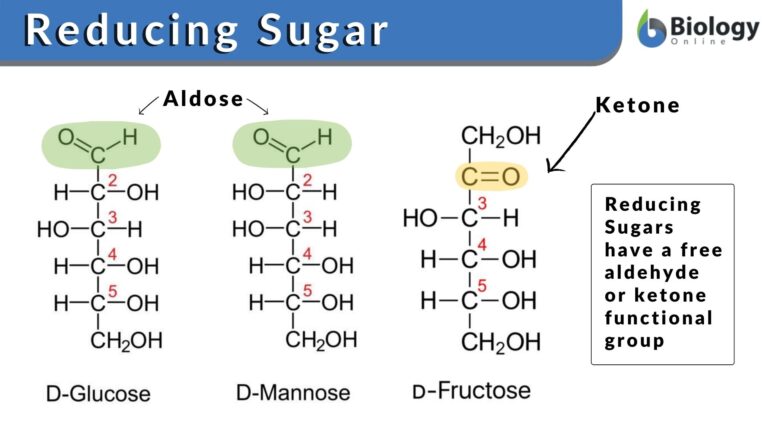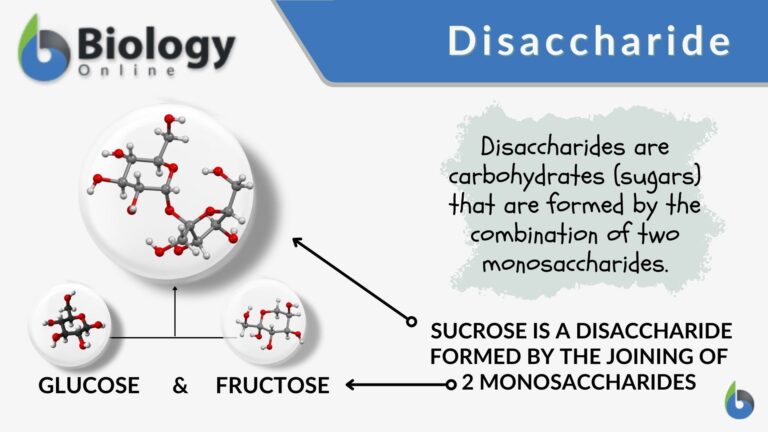
Monosaccharide
n., plural: monosaccharides
[ˈmɒ.nəʊˈsæk.ə.ɹaɪd]
Definition: one saccharide unit
Table of Contents
Monosaccharide Definition
In biology and biochemistry, a monosaccharide is a simple sugar that constitutes the building blocks of a more complex form of sugars such as oligosaccharides and polysaccharides. Examples are fructose, glucose, and ribose. The term monosaccharide etymologically means “single saccharide”. A saccharide refers to the unit structure of carbohydrates. Thus, a monosaccharide is a carbohydrate comprised of only one saccharide unit. The term sugar can refer to both monosaccharides and disaccharides. Monosaccharides are also called simple sugars since they are the most fundamental type of sugar. The term table sugar or granulated sugar actually refers to sucrose, which is a disaccharide made of two monosaccharides — glucose and fructose. Etymology: Ancient Greek μόνος (mónos, meaning “alone, single”) + saccharide. Synonyms: simple sugar; monosaccharose. Compare disaccharide, polysaccharide.
Overview
Carbohydrates are organic compounds comprised of carbon, hydrogen, and oxygen, usually in the ratio of 1:2:1. They are one of the major classes of biomolecules. They are an important source of energy. They also serve as structural components. As a nutrient, they can be classified into two major groups: simple carbohydrates and complex carbohydrates.
- Simple carbohydrates, sometimes simply referred to as sugar, are those that are readily digested and serve as a rapid source of energy.
- Complex carbohydrates (such as cellulose, starch, and glycogen) are those that need more time to be digested and metabolized. They often are high in fiber and unlike simple carbohydrates, they are less likely to cause spikes in blood sugar.
Characteristics of Monosaccharide
The most fundamental type is the simple sugars called monosaccharides. This means that they cannot be broken down any further into simpler sugars by hydrolysis. Nevertheless, monosaccharides can combine with each other to form more complex types.
Glycosidic bonds (also called glycosidic linkages) are the covalent bonds that join monosaccharides. The combination of two simple sugars is called a disaccharide whereas carbohydrates consisting of three to ten simple sugars are called oligosaccharides, and those with a larger number of monosaccharide units are called polysaccharides.
The chemical process of joining monosaccharide units is referred to as dehydration synthesis since it results in the release of water as a byproduct. The process, though, is reversible. Complex carbohydrates may be broken down into simple sugars, such as in glycogenolysis where stored glycogen is broken down into glucose units that could be used in energy metabolism.
A monosaccharide has a general chemical formula of CnH2nOn and its chemical structure is H(CHOH)nC=O(CHOH)mH. The ratio of hydrogen atoms to oxygen atoms is often 2:1. An exception to this is deoxyribose, a type of monosaccharide found in DNA. Because of this chemical formula rule, monosaccharides and other carbohydrates are referred to as hydrates of carbon.
Monosaccharides are often colorless, crystalline solids, and sweet-tasting. They can be dissolved in water and occur as syrups or liquid sugar. Just like the other carbohydrates, monosaccharides are organic compounds. They contain carbon covalently bound to other atoms, especially Carbon-Carbon (C-C) and Carbon-Hydrogen (C-H).
Classifications of Monosaccharides
Monosaccharides can be classified by the number of carbon atoms they contain. The groups are as follows:
- A triose is a three-carbon monosaccharide. An example is glyceraldehyde-3-phosphate (C3H7O6P). It is a triose that serves as an intermediate in different carbohydrate metabolic pathways.
- A tetrose is a monosaccharide with four carbon atoms. Some of the naturally-occurring tetroses are D-erythrose, D-threose, and D-erythrulose. The erythrose, C4H8O4, is a tetrose with one aldehyde group. It was first isolated by French pharmacist Louis Feux Joseph Garot in 1849. The erythrose 4-phosphate is a metabolite in the Calvin cycle and in the pentose phosphate pathway. Threose is a tetrose and an enantiomer of erythrose. Another enantiomer is erythrulose. It has the same chemical formula: C 4 H 8 O 4 . Nevertheless, erythrulose is a ketotetrose for having a ketone group in its structure.
- A pentose is a five-carbon monosaccharide. Examples of pentoses are ribose, deoxyribose, arabinose, lyxose, xylose, ribulose, and xylulose. Ribose (chemical formula C5H10O5) and deoxyribose (chemical formula C5H10O4) are constituents of nucleotides and nucleic acids. In particular, ribose is the pentose sugar component of the nucleotides of RNA whereas deoxyribose is the sugar component of the nucleotides of DNA.
- A hexose is a six-carbon monosaccharide. Examples of hexoses are glucose, mannose, galactose, gulose, idose, talose, allose, altrose, fructose, piscose, sorbose, and tagatose. Glucose, in particular, is the most common hexose that serves as a metabolic intermediate of cellular respiration. Excess glucose is stored as glycogen in animals and as starch in plants.
- A heptose is a seven-carbon monosaccharide. Examples of naturally-occurring heptoses are L-glycero-D-manno-heptose and sedoheptulose. Their chemical formula is C7H14O7. They are early intermediates in lipid A biosynthesis.
- An octose is an eight-carbon monosaccharide. Octoses have a chemical formula of C8H16O8. An example is methylthiolincosamide, i.e. the sugar moiety of the antimicrobial agent lincomycin A.
- A nonose is a nine-carbon monosaccharide. Examples of nonoses are neuraminic acid, sialic acid, legionaminic acid, and psudaminic acid. Neuraminic acid (chemical formula of C9H17NO8), in particular, is a synthetic nonose.
- It should be noted that these terms (e.g. triose, tetrose, pentose, etc.) are different from the terms trisaccharide, tetrasaccharide, pentasaccharide, and so on as the latter terms respectively signify the number of monosaccharide units in a polymer, i.e. three monosaccharides, four monosaccharides, five monosaccharides, and so on.
- Monosaccharides may also be classified based on the type of carbonyl group they contain: (1) Aldose, -CHO (aldehyde) and (2) Ketose, C=O (ketone). An aldose is a monosaccharide that contains an aldehyde group (-CHO) whereas a ketose is one that contains a ketone (C=O).
Common Monosaccharides
Fructose, glucose, and galactose are regarded as dietary monosaccharides since they are readily absorbed by the small intestines. They are hexoses with the chemical formula: C6H12O6. Glucose and galactose are aldoses whereas fructose is a ketose.

Glucose
Glucose is a monosaccharide that occurs naturally and is ubiquitous. It can join with other monosaccharide units to form disaccharides: maltose (i.e. two glucose molecules), lactose (i.e. glucose and galactose molecules), and sucrose (i.e. glucose and fructose molecules).
Glucose is one of the products of photosynthesis in plants and other photosynthetic organisms. In plants, glucose molecules are stored as repeating units of sugar (e.g. starch). It is also an important component of amylopectin and cellulose. Thus, it occurs abundantly in fruits, plant juices, and many other plant organs. It also serves as an important metabolic intermediate of cellular respiration and a major source of energy (via aerobic respiration or anaerobic respiration). In animals, it circulates in the blood and as such referred to as blood sugar. An excess of glucose in animals is stored as glycogen.
Galactose
Galactose is similar to glucose in terms of chemical structure. However, the orientations of H and OH on carbon 4 are exchanged. Unlike glucose, galactose generally does not occur in a free state. It usually is a constituent of complex biomolecules. For instance, galactose together with glucose forms lactose (milk sugar), which is a disaccharide. Lactose, the disaccharide of milk, consists of galactose joined to glucose by a -(1-4) glycosidic link. The joining of galactose and glucose is catalyzed by the enzymes lactase and β-galactosidase. Galactose catabolism (where glucose is converted to glucose) is carried out via the Leloir pathway.
In human lactation, one of the sources of lactose in breast milk is through de novo synthesis of galactose and glucose through hexoneogenesis. In plants such as the axlewood ( Anogeissus latifolia) and acacia trees, galactose monomers link together and form a polysaccharide referred to as galactan.
Fructose
Fructose is regarded as the sweetest naturally-occurring carbohydrate. Some of the natural sources of fructose are honey, fruits, and sugar cane. It is a ketonic monosaccharide since it has a reducing group (carbonyl) at carbon 2. This is in contrast to glucose (which is an aldose) that has its carbonyl group at carbon 1. Fructose occurs naturally in plants, particularly in fruits, root vegetables, etc. It occurs freely or bonded to glucose to form sucrose.
Biological Functions
Monosaccharides perform vital biological roles. One of their major functions is to serve as a structural unit for multifarious biological compounds. Through glycosidic bonds, they join together to form disaccharides, oligosaccharides, and polymers (e.g. cellulose, starch, and glycogen). They may also serve as a precursor or a constituent of other compounds, such as galactosamine, glucosamine, sialic acid, N-Acetylglucosamine, sulfoquinovose, ascorbic acid, mannitol, glucuronic acid, etc. Many of these compounds have a monosaccharide component that is involved in various biological functions.
Disaccharide formation
Sucrose (the common table sugar) is a non-reducing disaccharide that forms when glucose and fructose are linked together by an alpha linkage between carbon 1 of glucose and carbon 2 of fructose. When present as a component of dietary sucrose, the enzyme invertase in the small intestine cleaves sucrose into glucose and fructose. Too much fructose, though, could lead to malabsorption in the small intestine. When this happens, unabsorbed fructose transported to the large intestine could be used in fermentation by the colonic flora. This could lead to gastrointestinal pain, diarrhea, flatulence, or bloating.

Metabolism
Monosaccharides, just like the other carbohydrates, are an important source of nutrition. Monosaccharides are found in fruits, vegetables, and many other dietary sources. They are consumed and metabolized to derive metabolic energy (e.g. ATP) that fuels various biological activities. ATPs are chemical energy biologically synthesized through aerobic and anaerobic respiration.
:max_bytes(150000):strip_icc():format(webp)/cellular_respiration-8fcc3f1ad3e54a828dabc02146ce4307.jpg)
Glucose is the most common form of monosaccharide that the cell uses to synthesize ATP via substrate-level phosphorylation (glycolysis) and/or oxidative phosphorylation (involving redox reactions and chemiosmosis).
Monosaccharides that are not yet needed are stored as energy-rich polysaccharides. In plants, they make glucose and other monosaccharides by photosynthesis, and then they store them as starch in various plant organs, especially in fruits, seeds, rhizomes, and tubers.

Animals store them as glycogen in liver and muscle cells.
Metabolic Pathways Involving Monosaccharides
Monosaccharides are involved in many important metabolic pathways. Some of these metabolic pathways are:
- Glycolysis – the conversion of a monosaccharide into pyruvate, with the concomitant production of high-energy biomolecules
- Pentose phosphate pathway – an alternative metabolic route in breaking down glucose
- Gluconeogenesis – the conversion of non-carbohydrate precursors into a monosaccharide
- Glycogenolysis – the breaking down of stored glycogen into monosaccharide units
- Glycogenesis – the conversion of glucose into glycogen
- Fructose metabolism – where fructose, instead of glucose, enters the glycolytic pathway
- Galactose metabolism – where galactose enters the glycolytic pathway by first being phosphorylated and then converted into glucose-6-phosphate
Try to answer the quiz below to check what you have learned so far about monosaccharides.
See also
Notes
More info relating to carbohydrates and their role in our diet can be found in the developmental biology tutorial investigating a balanced diet. A Balanced Diet – Carbohydrates and Fat
© Biology Online. Content provided and moderated by Biology Online Editors




